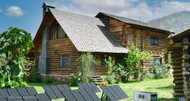SOLAR POWER FOR REMOTE CABINS AND VACATION HOMES: WHAT YOU NEED TO KNOW
4th Jun 2025
Solar power is an increasingly practical and cost-effective option for remote cabins and vacation homes, offering energy independence without the need for noisy generators or expensive utility connections. When designing a system for part-time or seasonal use, it’s essential to size your setup based on your actual energy needs during those peak usage months. Unlike year-round residences, these properties often have lower energy demands but can still require bursts of higher usage during holidays or gatherings. A detailed load calculation—including lighting, refrigeration, water pumps, entertainment systems, and seasonal heating or cooling—will help you determine the right system size. It’s usually wise to oversize slightly to account for less-than-ideal sun conditions or occasional guests.

Security and convenience are major concerns for remote properties. With advances in solar-powered automation, you can now integrate remote monitoring systems that allow you to check battery levels, system status, and even activate lights or cameras from afar. Many charge controllers and inverters support app-based platforms that provide live data and alerts. Adding motion-activated security lighting or surveillance cameras powered by solar ensures your property is protected even when you're not there, without the need for a constant power supply.
When your cabin or vacation home is located in a wooded or partially shaded area, solar panel placement becomes especially important. Ideally, panels should be mounted in the sunniest spot available, often on a pole or ground-mount system that can be tilted toward the sun. Roof-mounting may be convenient, but trees and roof angles can limit efficiency, especially in winter when the sun is lower. Trimming back branches or selecting a south-facing clearing can significantly improve performance. Even in dense forested areas, finding a sun-exposed gap or clearing and running wires a short distance to your battery bank may be worthwhile.
Despite careful planning, not every day will offer perfect sunlight. This is where backup solutions come into play. Batteries are essential for storing excess power generated during the day for use at night or during cloudy periods. For light-use cabins, a modest lithium or lead-acid battery bank might be sufficient. However, extended stretches of poor weather may require additional support. A generator can provide emergency power and recharge your batteries when solar alone can’t keep up. Some users opt for a hybrid approach, relying primarily on solar with a generator as a secondary backup.

Overall, solar power gives you the freedom to enjoy your getaway without sacrificing comfort or security. With thoughtful planning and the right setup, even the most remote locations can become reliable, energy-efficient retreats.
